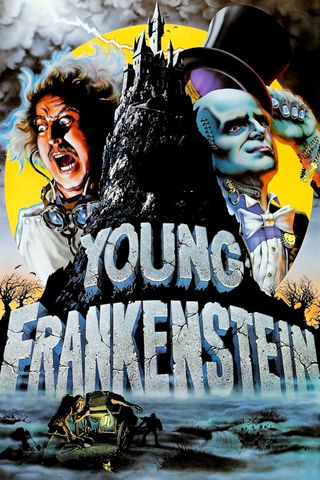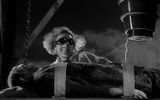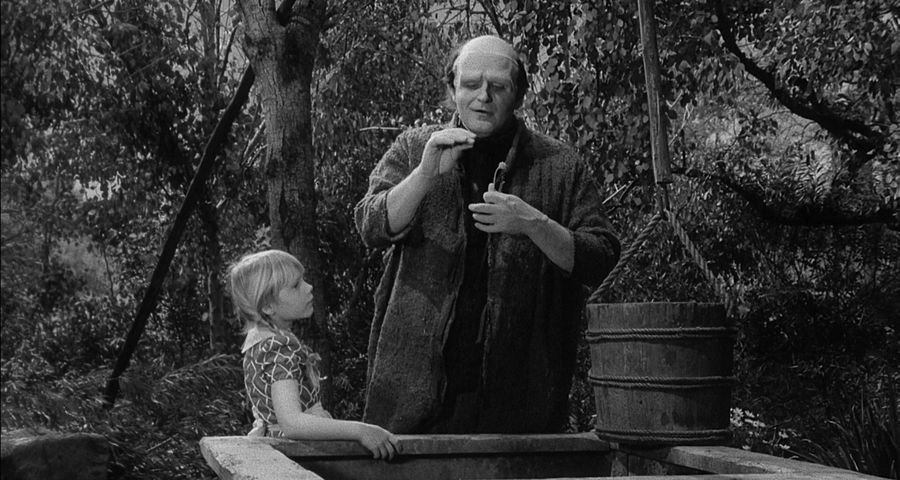SPOILERS

| Added | Tue, 14/06/2022 |
| Release date | 15-12-1974
|
| Original title | Young Frankenstein
|
| Феномены | |
| References |
"Young Frankenstein" (English: "Young Frankenstein") is a 1974 American parody comedy that plays out the plots and standard situations of classic black-and-white horror films.
The film was shot in the same scenery as the legendary "Frankenstein" of 1932.
The main character of the film is Frederick Frankenstein, the grandson of the famous Dr. Frankenstein, who teaches a course in medicine at an American university. He tries not to advertise his belonging to the infamous Frankenstein family (and insists that his last name is pronounced "Frankenstein"). Nevertheless, the doctor goes to Transylvania, as the family attorney informs him about the discovery of the will of his great-grandfather in the Transylvanian castle, according to which the estate becomes the property of the young Frankenstein.
Upon arrival at the ancestral nest, Frederick meets its inhabitants: the hunchbacked assistant Igor (who insists that his name is pronounced "Igor"), the beautiful blonde assistant Inga and the gloomy Frau Blucher - the mistress of his late grandfather. Awakened in the middle of the night by the sound of a violin (as it turns out later, Frau Blucher plays it), the doctor discovers a secret passage leading to his grandfather's secret laboratory.
With the help of his grandfather's notes, the young Frankenstein manages to revive the corpse of a huge man stolen from the cemetery. Soon it turns out that due to Igor's negligence, the doctor provided his creation with "abnormal" brains belonging not to a great scientist at all, as he believed, but to some kind of oligophrenic. The problems begin when Frau Blucher frees the monster from the chains, and he embarks on a journey around the neighborhood, scaring and crippling the locals.
The Doctor learns from Frau Blucher that the monster can only be subdued by the sounds of a violin. Using this secret, the inhabitants of the castle lure the monster into a trap. During the conversation with the monster, the doctor realizes that he responds to good with good, and to evil with evil. He takes the monster to Bucharest, where they dance together to the tune of "Puttin' on the Ritz" in front of a large crowd. Because of the boorish behavior of the audience, the performance is disrupted, and the monster ends up at the police station.
Meanwhile, the doctor's fiancee, the mannered Elizabeth, arrives at Frankenstein Castle from America. The doctor himself is already madly in love with the assistant by this time. Suddenly, a monster who escaped from the police appears in the castle and kidnaps Elizabeth. After eight copulations with the monster, Elizabeth ignites a passion for him, the reason for which lies in his extraordinary sexual strength and a huge "Schwanzstück" (the playful name of the penis).
The doctor, having again lured the monster into the castle, decides to take extreme measures – transplanting a part of his brain to him. In the midst of the operation, a crowd of angry peasants, led by a comical police inspector Hans Wilhelm Friedrich Kemp, breaks into the castle. The monster, now endowed with reason, calms the crowd with his wise exhortations. The film ends with a happy ending: Elizabeth is happy with the monster, and Frederick is happy with Inga.
Phenomena in artwork: Zombies
The living dead is a monster created by Frederick Frankenstein, the grandson of the famous Victor, using instructions left by his grandfather. The creature is assembled from only two parts: the bodies of a hanged man and an "abnormal" brain of unknown origin. The scientist had only one requirement for the body – its size: to simplify the work, the source material should be as large as possible, at least 7 feet tall.
The process of reviving the monster fully corresponds to the one demonstrated in the original film. The monster does not come to life immediately, but only a few hours after the procedure.
The monster is characterized by great strength and initially shows aggression, but as the film progresses, it becomes calmer. He is afraid of fire and does not talk, only makes inarticulate sounds. Frankenstein teaches him to walk, dance and even sing along in a musical number.
At the end of the picture, Frankenstein performs another operation and shares a part of his brain with the monster, which makes him intelligent and allows him to live an ordinary human life. The effect of this procedure on the mind of Frankenstein himself remains undisclosed.
Phenomena in artwork: Werewolf
The werewolf is not shown in the film, but the characters mention him when they hear a wolf howling near Frankenstein's Castle.
Log in or register to post comments








